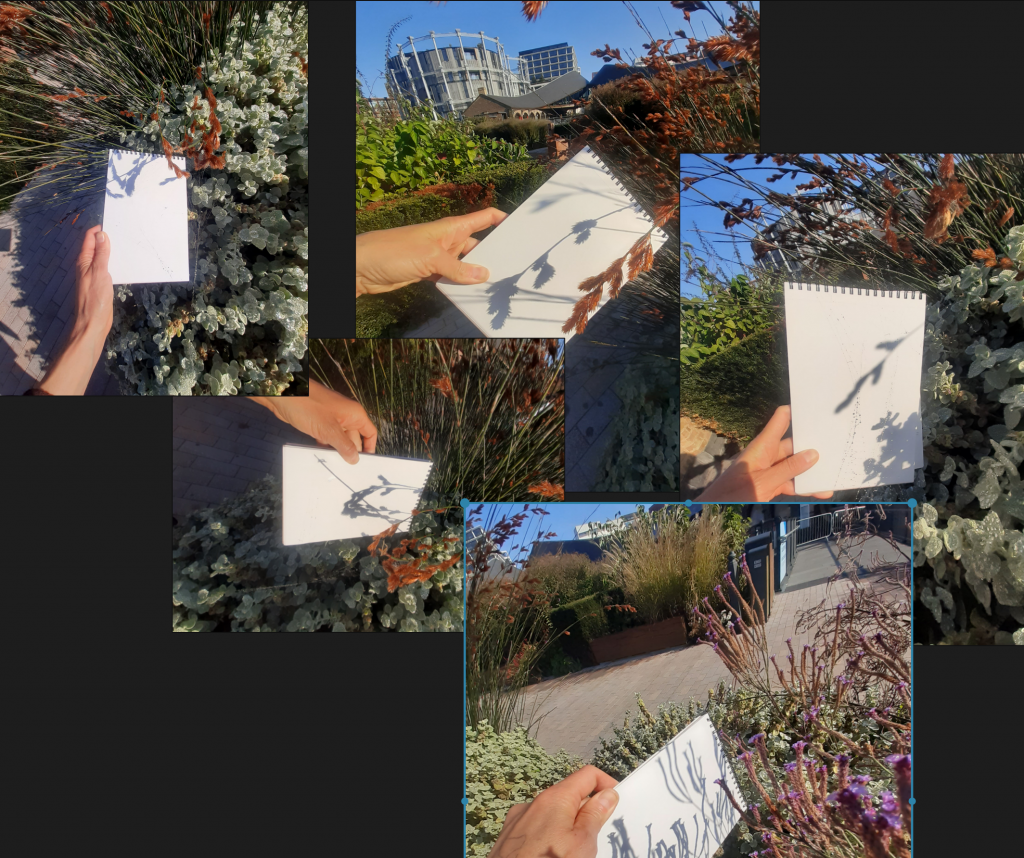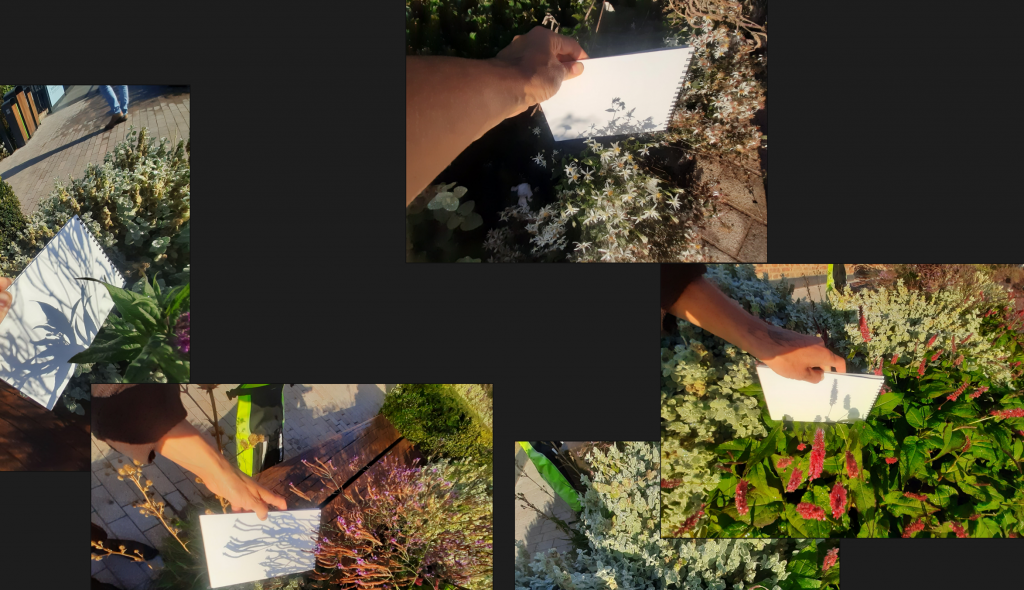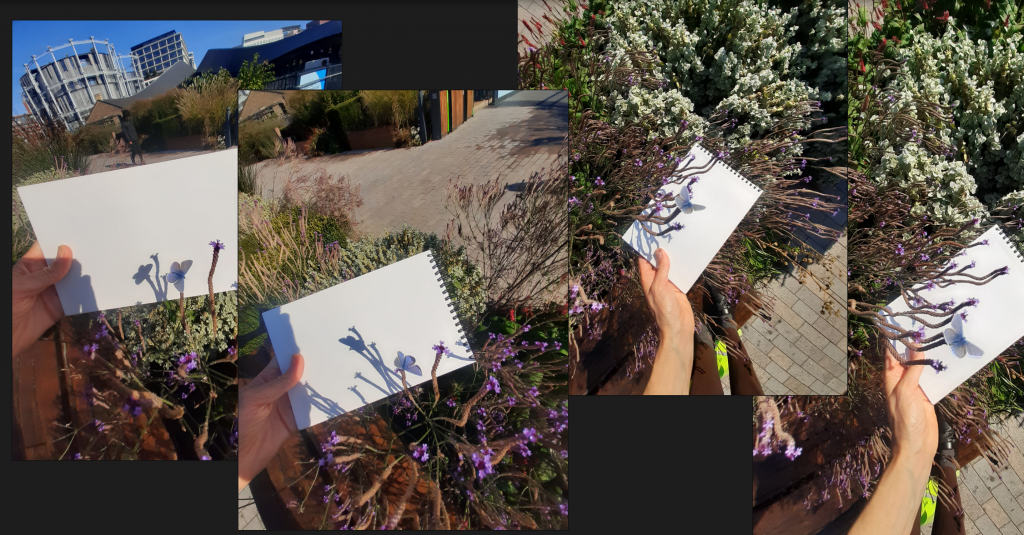Notes and records from week 2
The following notes were taken on Monday 29 Sep
(8.30am-11am)
3 people are drinking hot drinks in take away cups from Costa, chatting, they leave after 5mins, none of them sit down, the seats are soaking wet with dew from the foggy morning. They stand near to bench A.
2 people come stand by the wall over looking the nature reserve, they separate themselves from the other 3, and stand right up against the right side hedging.
It’s become a very clear bright morning with a stark blue sky and warm sun, after quite a thick fog, perhaps the first of this autumn.
On the ground in front of bench are the remnants of people smoking hand rolled cigarettes, a couple of shreds of cig papers, two butts, and small pieces of cards – makeshift filters. There are also 2 ready made cig butts in the garden bed and several in between the paving where there is no grout. There is another tailor cig butt in the plant to the left of bench A.
All the plants are wet, the weight of the dew has made the verbena droop towards the walkway behind the benches, it looks a bit like a huge head of hair being parted.
Sun is reflecting bright off the wet stone walkway.
The box hedge seems to have more new growth tips, they are a pale yellowy green and covered in shining drops of dew, perhaps that is what make them more prominent or that I’m looking at them from a standing position, from in front of bench A, previously I’ve ben sitting next to hedge on bench B.
The dried heads of the Eryngium next to bench a have absorbed the dew, likewise with the browned flower parts of the Verbena, whilst the tiny few remaining purple blooms are still wet.
The hairy horehound seems to be the most hydrophobic, its leaves have very bulbous drops that sit on top, whereas the Persicaria next to it with its smoother green leaves pool the dew and the arrowhead shaped leaves and their downward-sloping connection to the stem will likely funnel the water down onto the plants base. The Horehound’s top 2 pairs of opposite alternating leaves also lead downwards to the plant’s stem but the water doesn’t look to be pooling or gathering in a way that would easily move in that direction. In fact on the larger leaves further down the stems it seems to be gathering into large droplets on the leaf tip.
It’s 9.06am and I see 2 honey bees on the Persicaria.
I see the same blue staffy as I did last Wednesday morning.
9.15am someone’s small dog falls in the canal, the owner is wailing and screaming, it’s hard to determine at first if she is in danger herself. The small dog can swim and someone climbs down the lock to pull it out of the water.
Another person comes into the site to watch the dog rescue against the wall, though its not a very good viewing location.
Once the dog is out the 2 people leave by the right hedge and the third person too.
It’s 9.22am and there are less people around. I stand by the wall, see 2 coots in a similar place to last week. I can hear construction machinery in the distance to my left and the water running thru the lock to my right. I hear a wren and a sparrow and see a moor hen. A cormorant flies overhead toward the nature reserve. The church bell rings, it’s 9.25am, I wonder why it’s marking that time?
The garden orb spider is still in the same place. I see a yellow and black striped hover fly on the Horehound. The spider’s web is partially destroyed, heavy with dew.
A bumble bee at 9.33am. It’s got a rich amber shoulder and amber and black striped abdomen. Another bumble bee, they seem most interested in Horehound and Verbena. The honey bees in the Persicaria.
There are now three honey bees 9.54am
I find two 1st instar southern green shield bugs on the asters.
The dew is drying off the Persicaria at the southern end of the bed, and the verbena next to it, which looks to be standing up a bit more. The horehound on the southern edge is still very wet, glistening. I see a fly, shiny blueish, common.
I spend time measuring with a measuring tape.
Measurements
These heights as well as the widths and diameters feed into a 1:50cm scale map of the site, a scale map isn’t going to show me anything new.
Maximum heights of plants, have included a range where there are multiple plants or a lot of variation in one plant:
- Horehound:60-80cm
- Verbena: 130-160cm
- Aster:40-50cm
- Hedges:93-98cm
- Rush: 230cm
- Geranium: 20cm
- Persicaria: 75-80cm
- Eryngium: 104cm
Two people with wheelie suitcases stop and look over the wall towards the lock.
I stop at 10.29am for a snack and drink. It is warm!
3 mallards, 2 males and 1 female down on the water. It’s still too wet to sit on the bench so lean on the wall, using it as a table for my flask and cup. A coot, a blue dragon or damsel fly. A shoe is floating, sole up, in the canal.
A hover fly behind me and a honey bee flies off over the water. Another hover fly and a small flying thing, flitting around, not landing, maybe a soft powdery winged thing so it can’t land on the wet plants.
I take a series of quick photos of the plants shadows captured on my notepad, trying to take advantage of the bright sun casting good shadows and to get a better look at their outer shape without being distracted by other details of the plants.



I see two flies mating by the horehound. A Small Blue butterfly on the verbena. Its iridescent a little bit purple and a very pale creamy-green colour on the other side of its wings. I try to capture it on camera with a white sheet behind but clumsily knock the plant and scare it off
It comes back and I manage to get some photos with white paper behind it. It doesn’t seem to mind me being close.

I go back to measuring 10.43am and then produce this map:

I draw some more plant parts, concentrating on the tips, but not the flowers, I want to se how the visible parts of the stems and leaves grow and mature. I’m also interested in the seed heads that have formed after the flowers and wonder how many of the plants are likely to naturalise in these beds, as there are so few weeds is that because there is not space for new seedlings to spring up? Or because of weeding labour done by a maintenance team?

Eryngium eburneum
focused on the seed head/flower arrangement and of leaves up the dried out stems.

Persicaria amplexicaulis ‘Firetail’ focused on leaves and stem, only capturing bottom of the flower spike.

Greek horehound Ballota pseudodictamnus, tips of stems with new (non-flowered) growth and trying to draw the growth arrangement of leaves and flowering parts.
Fauna record tally
- People: 3 (stay for 5mins, drinking coffee), 2 (stay for 30mins, drinking coffee), 1 (stays for 7mins), 2 (stay 2mins), 1 (me, stays for 2hr 30mins)
- 4 bumble bees
- 3 honey bees
- 2 shield bugs
- 3 flies
- 3 hover flies
- 1 butterfly
- 1 damsel/dragonfly
- 1 mystery butterfly/moth/fly
- 1 garden orb spider (same as previous Wed)
- Heard a wren
- Heard a sparrow
- 2 moorhens
- 2 coots
- 1 cormorant
- 1 blue staffy (same as previous Wed)
- 3 mallard ducks
Evidence of: 8 kinds of birds (I assume the additional presence of pigeons and wood pigeons); 9 kinds of insect; domestic dogs, one I’ve seen here before, one in the canal(!); 9 people enter the small site (myself included). Time frame 8.30am to 11am.
Built components
focused on materials
All the components I can see are grey or brown (loosely):
The bricks in the wall: are orange/reddish brown or dark grey, with a smaller number of a dirty yellow grey (Thames Estuary mud?). The concrete holding them together has yellowed and contains small stones throughout. One the top surface fo the wall there is lichen on the bricks, black, acid yellow-green and a mustardy yellow, smaller patches of grey green lichen. Also patches of what looks like black paint, thick and smoother than the bricks. The bricks are very roughly finished, pock marked and some have creases formed by air when the clay has been pressed into the brick mold. Someone has stuff a cigarette butt into one of the larger crevices in the bricks.
At the base of the wall: covering the bottom 17cm of bricks is a metal guard.
On the floor: are 10cm wide, and 20cm/25cm/30cm long paving stones in perpendicular lines to the base of the wall. I cannot pick out a pattern in the choice of paver length, other than nearby rows never have pavers ending in the same spot. The pavers are all stone, possibly granite and range in colours/tones, there seem to be 3 varieties: 1 rough surface in mostly grey, 1 rough surface in a warmer grey with some soft brown, 1 smoother surface mostly grey. There are the similar particles in each variety, just in different quantities and finishes.
The benches: have been painted in a warm brown varnish, you can se th weathered grey where the varnish is cracking off around the deeper fissures in the bench wood. Set into the top of each bench are 6 5cm diameter wooden circles. It is unclear what they are for, but assume to do with fixing them in place or more to hide whatever unsightly materials are holding them in place. I get down on the ground to peer into the 10cm gap between the bench and the ground and it’s a mess, there is trashed shoved in the gap and I now realise people are slipping trash between the two slabs that make up each bench, mostly cigarettes and food packaging.
Two members of the Estates crew arrive, it’s 11am, they are litter picking, there is no litter large enough or visible enough for them to take.
Notes and drawing
I wrote some more focused plant notes, incorporating small drawings as I wrote. Below is a roughly typeset version with the images set in a similar way to my handwritten notes.

Leave a Reply